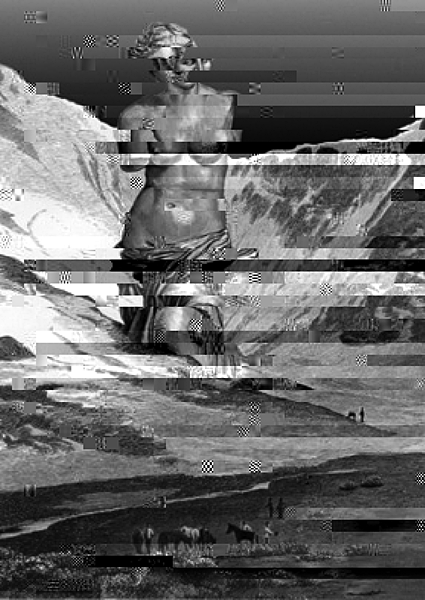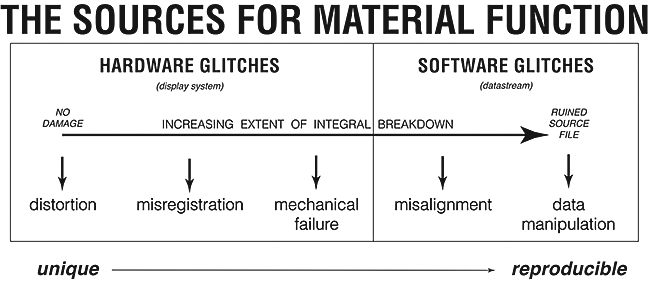|
My new book Glitch Art in Theory and Practice: Critical Failures and Post-Digital Aesthetics has been officially announced on the Routledge website! (152 pages | 35 B/W Illus.) Preorder on amazon.com.

Glitch Art in Theory and Practice: Critical Failures and Post-Internet Art explores the concept of "glitch" alongside contemporary digital political economy to develop a general theory of critical media using glitch as a case study and model, focusing specifically on examples of digital art and aesthetics. While prior literature on glitch practice in visual arts has been divided between historical discussions and social-political analyses, this work provides a rigorous, contemporary theoretical foundation and framework.
This book discusses the connections between contemporary uses of technical failure and historical avant-garde materialist film practices. It puts the contemporary "glitch" into a historical framework. Artists producing visual glitches have engaged in a limited range of protocols for their creation and deployment in their work. This book is concerned with the potentials contained by understanding glitch through a general framework addressing the types of manipulation and their relationship to the digital technology that produces the work. This production of glitch falls into five general (historical) categories that begin with the digital file itself and progress towards the physical presentation of the work, shifting from a manipulation of the virtual, digital instructions that are the file towards the literal presentation of that file for an audience.

Central to this analysis are the connections between historical materialist film practices and the physical nature of digital systems. These overlaps can be summarized as a series of approaches implicit in the analysis of Glitch Art in Theory and Practice:
(1) Data Manipulation
Data manipulation covers a range of approaches and protocols, all of which are focused on the transformation and alteration of the digital file itself: its dataset is changed to induce aberrant results when �played� normally on a computer. These varieties of glitching are the most immediately recognized as being glitch, and are readily apparent as specific, named protocols such as �data moshing� in which a video file compressed using MPEG-1 has crucial image data removed (the I-frames), resulting in a cascading failure as the motion data is not refreshed with corresponding image data; Takeshi Murata's Monster Movie employed this technique to produce its distinctive effects. Other variants of data manipulation, such as �data bending� involve the introduction of transient errors into the datastream that also produce cascading failures. The occasional �drop-outs� in digital video feeds (commonly seen during bad weather) are common examples of these transformations. Direct transformations of data to introduce errors and overflows when the file is rendered for a human audience overlap with transformations of the data using incorrect and inappropriate software, resulting in convergent results when encountered in human readable form.
(2) Misalignment
Misalignment between a digital file and the software that reads that file has two mirror-like variants: the first produces errors through the inappropriate application of decompression by decoding of a compressed file using an incorrect codec, resulting in a transformation of the encoded data, but without damaging the file itself; the second involves the induced opening/reading of a file using an incorrect software application. For example, opening a motion-encoded video file as audio, manipulating the audio-version of the dataset, then engaging the results either as audio, or returning it to be video again. Both these approaches involve mismatches between encoded data and its decoding, resulting in aberrant results when rendered for a human audience. Rosa Menkman's glitch-generating software Monglot creates its effects through the misalignment of encoded data with the codec for decoding it.
(3) Hardware Failure
Familiar from electronic music, the most famous type of hardware failure is �circuit bending,� the creation of short circuits and physical �failures� in the hardware that renders electronic signals for a human audience. These physical failures in the technology itself (as distinct from software) produce glitches and aberrant results without necessarily altering the digital files being presented. The protocols used in the production of Jay Fenton's Digital TV Dinner are examples of this physical engagement with technology that induces a glitch.
(4) Misregistration
The �noise� of historically analog recording technologies--the dirt, scratches, smudges and markings that can distort phyiscal media also impact the playback of digital recordings on media such as CDs and DVDs where the data is accessed physically rather than electronically. The same physical interruptions that impact analog recordings can also distort and interrupt digital recordings that are physically stored. Most familiar from electronic music at the start of the twenty-first century, this approach to glitching engages the interface between the physical storage of the data and the data itself. The material markers of celluloid film that feature prominently in structural and materialist films of the 1960s-1970s involve the inclusion of this �noise� in the presentation itself.
(5) Distortion
Physical malfunctions of/in the presentation itself--problems with video screens, optical misalignments and electronic failures in video projectors for example are all physical failures that manifest as a distortion of the resulting presentation without altering or impacting the data itself. These mechanical faults and failings are the most common, and at the same time, the most transient. They reside in the particular device itself rather than being a feature of the data displayed. The earliest varieties of glitch belong to this category of failure: the RCA TV receiver repair manuals published in the 1950s are concerned with the correction and identification of these physical failures in the display itself.
�Glitch� techniques align with particular sites of technological manipulation, yet all of them share an underlying engagement with the unexpected and aberrant behaviors of machinic systems proceeding autonomously. It is this particular engagement with the system as a such as it fails--no matter the particulars of that breakdown--that defines glitch techniques as an ongoing process of investigation, whatever the human readable form might be.
This excerpt from my book summarizes some of the taxonomic discussion..
|